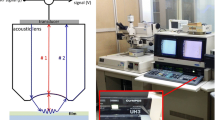Abstract
Optical properties are very important property in semiconductors, which are related to the following concepts: hardness, piezoelectric constants, bulk modulus and yield strength, etc. In this paper, ZnO films of thickness 100 nm were deposited on Silicon substrate and observed that emission and excitation spectra of ZnO film using 325 nm HeCd laser as the exciting source with energy 20 mW. Structure and composition of the ZnO/Si films have been investigated by X-ray diffraction (XRD), atomic force microscopy (AFM), scanning electron microscopy (SEM) and X-ray photoelectron spectroscopy (XPS) for chemical composition.
Access provided by Autonomous University of Puebla. Download conference paper PDF
Similar content being viewed by others
Keywords
1 Introduction
Zinc oxide (ZnO) is of great interest as a suitable material for high temperature, high power electronic devices either as the active material or as a suitable substrate for epitaxial growth of group III-nitride compounds. With its large, direct band gap ≈3·4 eV, a low-power threshold (~160 μJ cm−2) for optical pumping at room temperature and wurtzite crystal structure, ZnO is similar to GaN. Due to its relatively close match in lattice constants, it may be used as a substrate for GaN and AlN epitaxy. As a consequence, there is renewed interest in the properties of ZnO relevant for microelectronic device applications. ZnO thin films have been prepared by a wide variety of techniques, including sputtering, spray-pyrolysis, and electro deposition [1] etc. In particular, the r.f. sputter method has advantages over other processes because of its simplicity [2]. We investigate the optical properties of r.f. magnetron Sputter ZnO/Si films by photoluminescence (PL) measurements, Structure and composition of the ZnO/Si films have been investigated by X-ray diffraction (XRD), atomic force microscopy (AFM), scanning electron microscopy (SEM) and X-ray photoelectron spectroscopy (XPS) for chemical composition.
2 Experiment and Results
The undoped ZnO (100 nm) thin film deposited on Si (100) at 450 °C using 13.56 MHz r.f. magnetron sputtering system with a base pressure of 1.0 × 10−6 Torr., working pressure of 1.0 × 10−2 Torr., used gas of Argon, substrate temperature of 450 °C with RF power of 100 W. In the XRD pattern (Fig. 1) a major peak of preferential orientation along (103) and minor one related to (002) of the undoped ZnO films were observed. It indicates that ZnO films are polycrystalline structures.
Figure 2 shows the atomic force micrograph of ZnO film. The scan was taken on a 5 μm × 5 µm area. The statistical information of the topography of the ZnO films as observed from the height histogram of the AFM image are: Rms surface roughness (Zrms) and average roughness (Zav) were found to be 50.9 and 30.4 Å, respectively.
A scanning electron microscopy (SEM) image of the cross-sectional view of ZnO/Si film (Fig. 3) shows columnar growth which indicates an orientation parallel c-axis (002) with thickness 100 nm.
Figure 4 shows core levels of Zn 2p of the ZnO films measured by X-ray photoelectron spectroscopy (PHI-5800). The as-grown ZnO thin film of the peaks of Zn 2p are found to be at 1044·8 eV and 1021·7 eV for Zn 2p1/2 and Zn 2p3/2, respectively, with a separation of 23·1 eV between the two peaks which is due to the Zn 2p state.
To investigate the optical properties of the films, photoluminescence (PL) measurements were performed Under the 325 nm excitation, the emission PL spectra of a ZnO film at different temperatures are shown in Fig. 5. From the emission spectra, it is clearly found that there is two emission bands peaked at 380 nm (UV band) and 502 nm (green band) for all. The origin of the 380 and 502 nm bands has been ascribed to the band edge radiative recombination and intrinsic defects (mostly O vacancy) of ZnO, respectively in many reports [3]. From Fig. 6, it can be found that the intensity of 380 and 502 nm emission decreases when the sample temperature is increased. When the temperatures are higher than 100 K, the 502 nm emission disappears [4]. Meanwhile, the intensity of 380 nm increases as the sample temperature increases, until it reaches 200 K.
Afterwards, the intensity of 380 nm decreases when the sample temperature continues increasing. The integrated intensities of 380 and 502 nm emission peaks at different temperatures are shown in Fig. 6, which were calculated from the area under the curves of related emission peaks in Fig. 5.
3 Conclusion
The r.f. magnetron sputter ZnO/Si films has been studied. Physical and chemical characterizations of the films were investigated using AFM, SEM, XRD and XPS. Due to its attractive properties ZnO films may have attracted much interest of potential commercial application in Photo voltaic Solar cell and optoelectronic devices, such as light-emitting diodes, laser diodes and UV photo detectors.
References
A. Moustaghfir, E. Tomasella, S. Ben Amor, M. Jacquet, J. Cellier, T. Sauvage, Structural and optical studies of ZnO thin films deposited by r.f. magnetron sputtering: influence of annealing. Surf. Coatings Technol. 174–175, 193–196 (2003)
A.E. Rakhshani, Characterization and device applications of p-type ZnO films prepared by thermal oxidation of sputter-deposited zinc oxynitride. J. Alloy. Compd. 695, 124–132 (2017)
W. Water, S.Y. Chu, Physical and structural properties of ZnO sputtered films. Mater. Lett. 55, 67–72 (2002)
S. Tanaka, K. Takahashi, T. Sekiguchi, K. Sumino, J. Tanaka, Cathodoluminescence from fractured surfaces of ZnO varistors. J. Appl. Phys. 77, 4021–4023 (1995)
Author information
Authors and Affiliations
Corresponding author
Editor information
Editors and Affiliations
Rights and permissions
Copyright information
© 2019 Springer Nature Switzerland AG
About this paper
Cite this paper
Nandi, S.K. (2019). Studies of Optical Properties of RF Magnetron Sputtered Deposited Zinc Oxide Films. In: Chattopadhyay, S., Roy, T., Sengupta, S., Berger-Vachon, C. (eds) Modelling and Simulation in Science, Technology and Engineering Mathematics. MS-17 2017. Advances in Intelligent Systems and Computing, vol 749. Springer, Cham. https://doi.org/10.1007/978-3-319-74808-5_1
Download citation
DOI: https://doi.org/10.1007/978-3-319-74808-5_1
Published:
Publisher Name: Springer, Cham
Print ISBN: 978-3-319-74807-8
Online ISBN: 978-3-319-74808-5
eBook Packages: EngineeringEngineering (R0)










